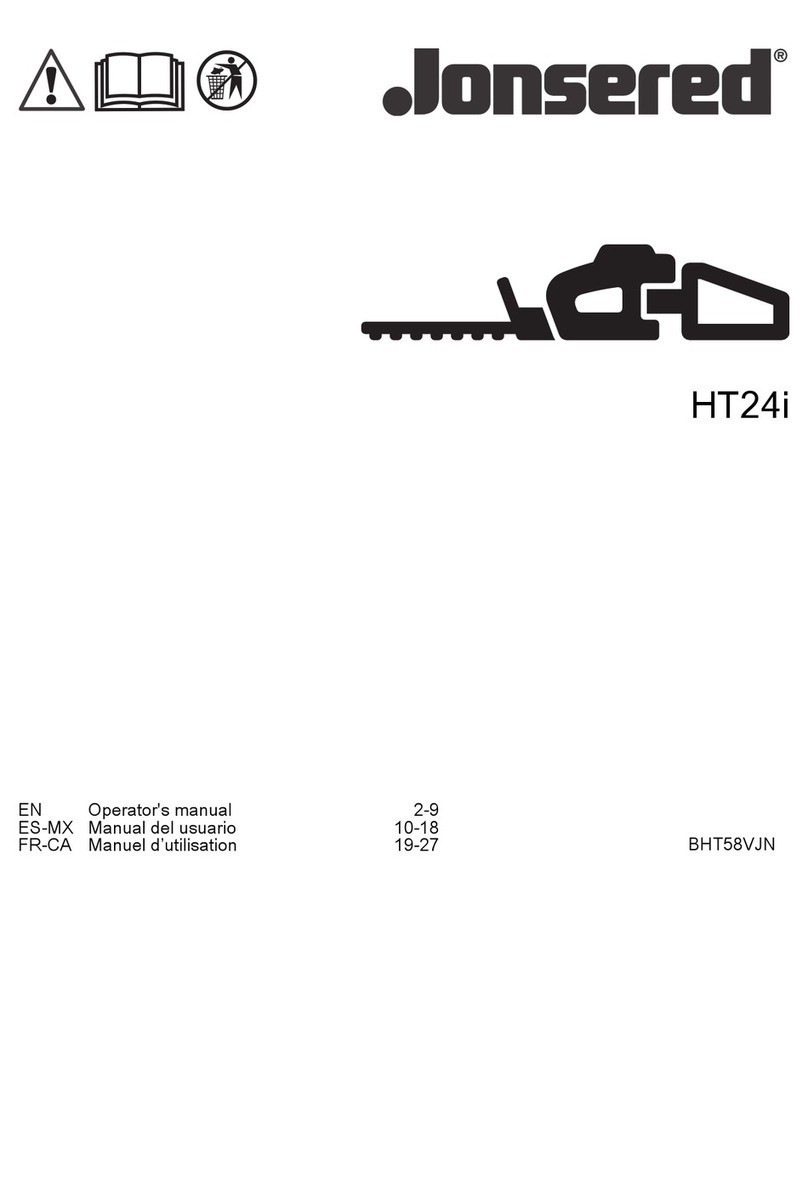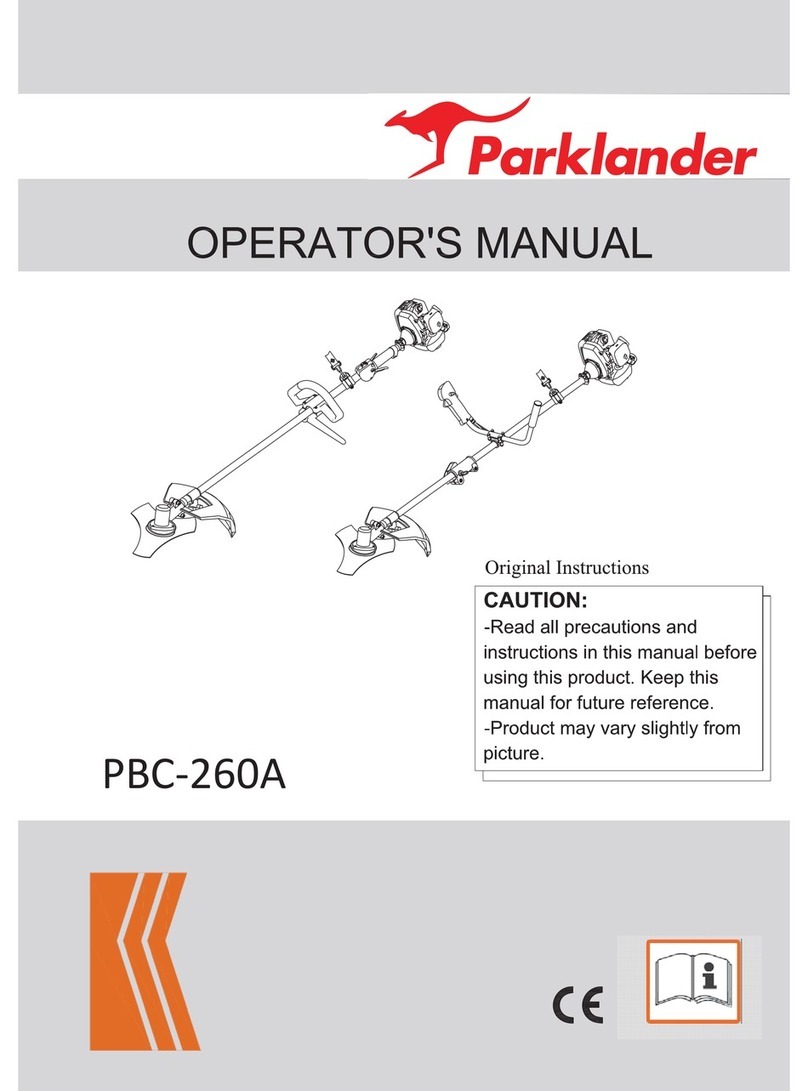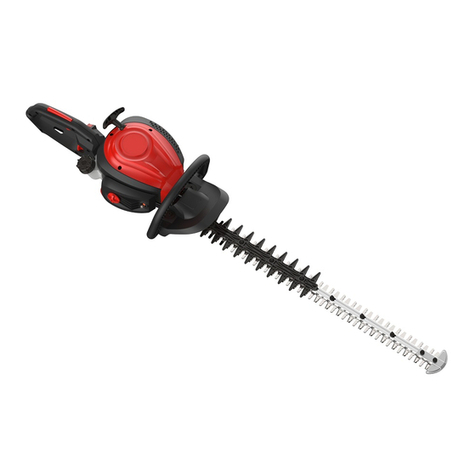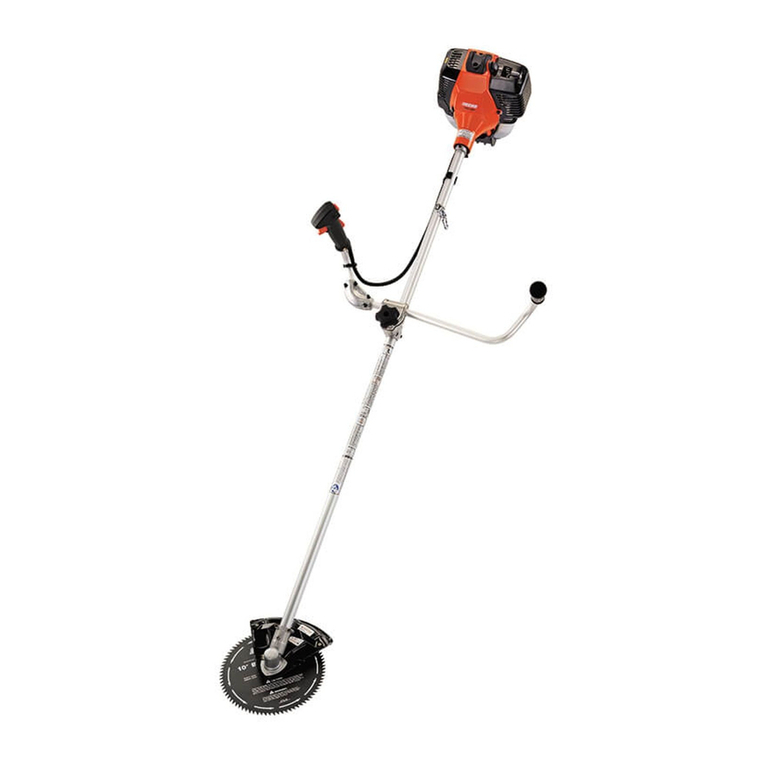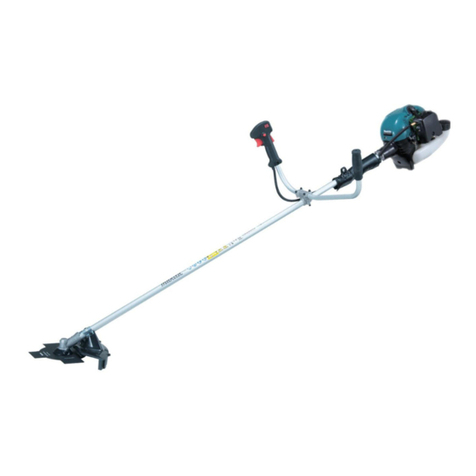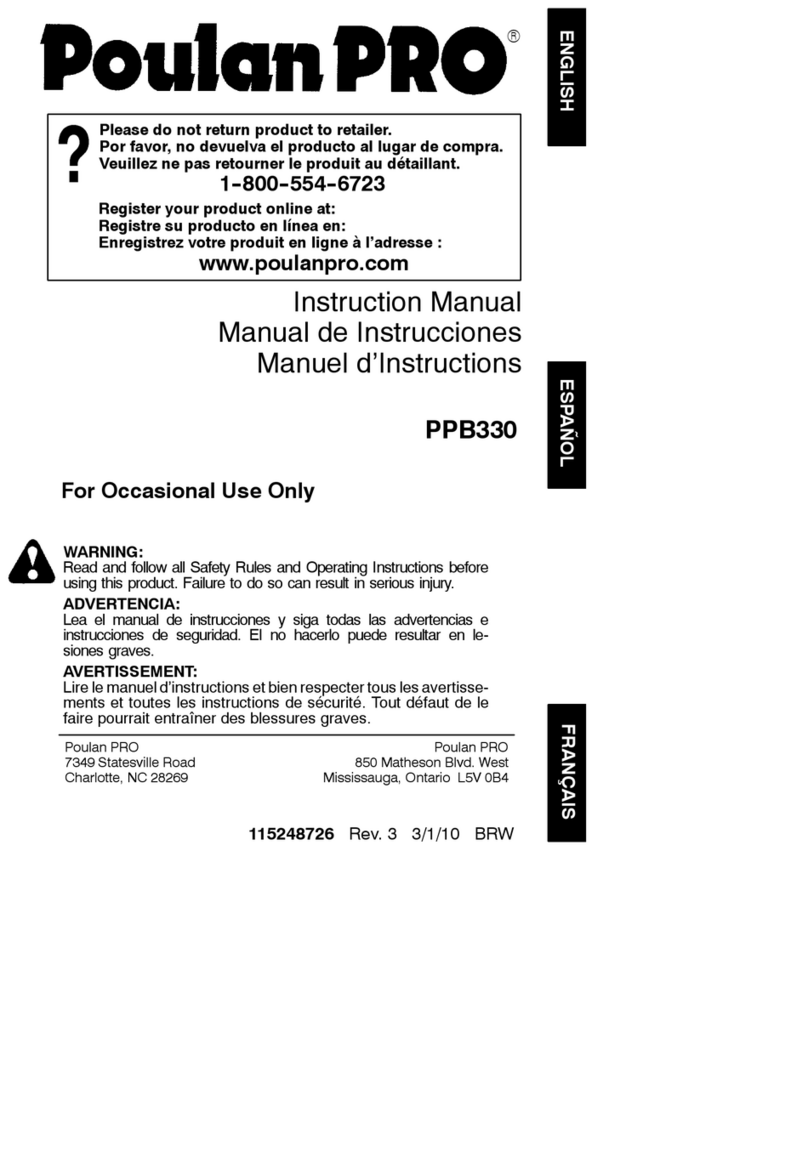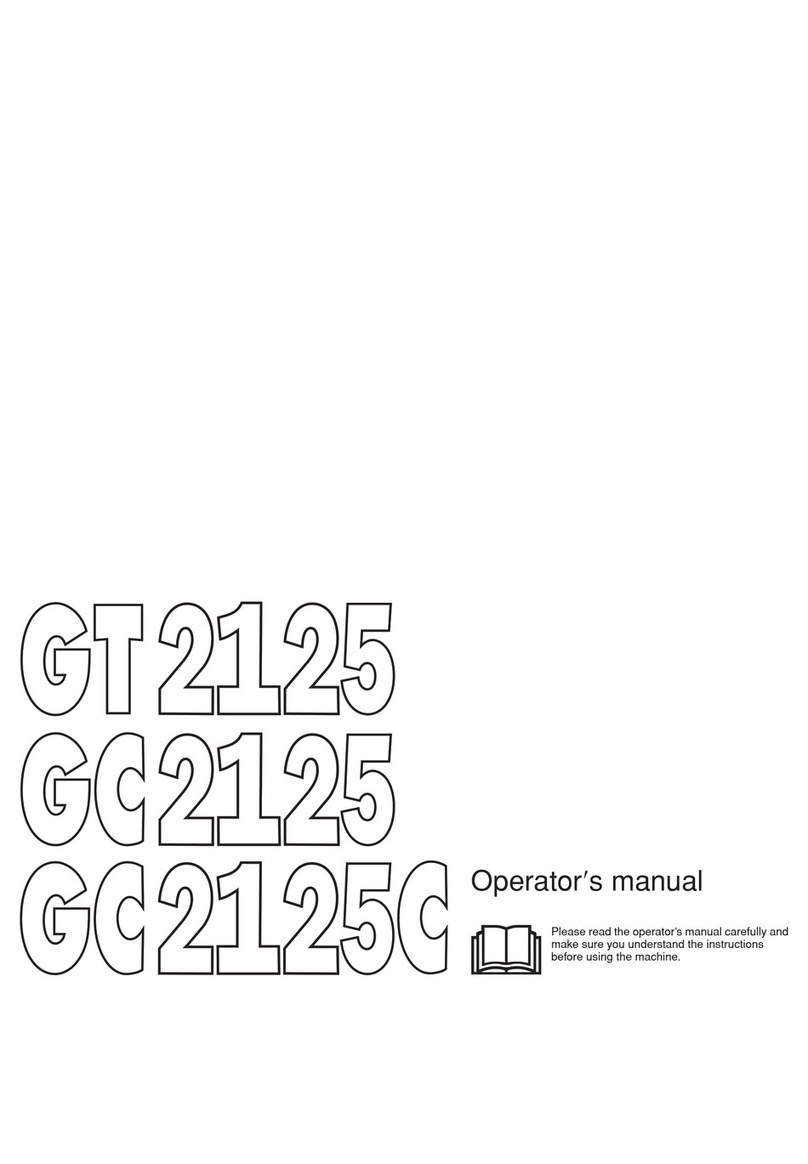Stanley FatMax BLACK+DECKER GTC1445L User manual

www.stanley.eu
GTC1445L
GTC1845L
GTC1845L20
GTC1850L
GTC1850L20

2
D
C E
A B
0-15

3
FG

4
ENGLISH (Original instructions)
Intended use
Your BLACK+DECKERTM, GTC1445L, GTC1845L,
GTC1845L20, GTC1850L, GTC1850L20 hedgetrimmer has
been designed for trimming hedges, shrubs and brambles.
This tool is intended for consumer use only.
Safety instructions
General power tool safety warnings
Warning! Read all safety warnings and all
instructions. Failure to follow the warnings and
instructions listed below may result in electric
shock, re and/or serious injury.
Save all warnings and instructions for future reference.
The term "power tool" in the warnings refers to your mains
operated (corded) power tool or battery operated (cordless)
power tool.
1. Work area safety
a. Keep work area clean and well lit. Cluttered or dark
areas invite accidents.
b. Do not operate power tools in explosive atmospheres,
such as in the presence of ammable liquids, gases
or dust. Power tools create sparks which may ignite the
dust or fumes.
c. Keep children and bystanders away while operating a
power tool. Distractions can cause you to lose control.
2. Electrical safety
a. Power tool plugs must match the outlet. Never modify
the plug in any way. Do not use any adapter plugs
with earthed (grounded) power tools. Unmodied plugs
and matching outlets will reduce risk of electric shock.
b. Avoid body contact with earthed or grounded
surfaces such as pipes, radiators, ranges and
refrigerators. There is an increased risk of electric shock
if your body is earthed or grounded.
c. Do not expose power tools to rain or wet conditions.
Water entering a power tool will increase the risk of
electric shock.
d. Do not abuse the cord. Never use the cord for
carrying, pulling or unplugging the power tool. Keep
cord away from heat, oil, sharp edges or moving
parts. Damaged or entangled cords increase the risk of
electric shock.
e. When operating a power tool outdoors, use an
extension cord suitable for outdoor use. Use of a cord
suitable for outdoor use reduces the risk of electric shock.
f. If operating a power tool in a damp location is
unavoidable, use a residual current device (RCD)
protected supply. Use of an RCD reduces the risk of
electric shock.
3. Personal safety
a. Stay alert, watch what you are doing and use common
sense when operating a power tool. Do not use a
power tool while you are tired or under the inuence
of drugs, alcohol or medication. A moment of inattention
while operating power tools may result in serious personal
injury.
b. Use personal protective equipment. Always wear eye
protection. Protective equipment such as dust mask,
non-skid safety shoes, hard hat, or hearing protection
used for appropriate conditions will reduce personal
injuries.
c. Prevent unintentional starting. Ensure the switch is in
the off-position before connecting to power source
and/or battery pack, picking up or carrying the tool.
Carrying power tools with your nger on the switch or
energising power tools that have the switch on invites
accidents.
d. Remove any adjusting key or wrench before turning
the power tool on. A wrench or a key left attached to a
rotating part of the power tool may result in personal injury.
e. Do not overreach. Keep proper footing and balance at
all times. This enables better control of the power tool in
unexpected situations.
f. Dress properly. Do not wear loose clothing or
jewellery. Keep your hair, clothing and gloves away
from moving parts. Loose clothes, jewellery or long hair
can be caught in moving parts.
g. If devices are provided for the connection of dust
extraction and collection facilities, ensure these are
connected and properly used. Use of dust collection can
reduce dust-related hazards.
h. Do not let familiarity gained from frequent use of tools
allow you to become complacent and ignore tool
safety principles. A careless action can cause severe
injury within a fraction of a second.
4. Power tool use and care
a. Do not force the power tool. Use the correct power
tool for your application. The correct power tool will do
the job better and safer at the rate for which it was
designed.
b. Do not use the power tool if the switch does not turn it
on and off. Any power tool that cannot be controlled with
the switch is dangerous and must be repaired.
c. Disconnect the plug from the power source and/or the
battery pack from the power tool before making any
adjustments, changing accessories, or storing power
tools. Such preventive safety measures reduce the risk of
starting the power tool accidentally.
d. Store idle power tools out of the reach of children and
do not allow persons unfamiliar with the power tool or

5
ENGLISH
(Original instructions)
these instructions to operate the power tool. Power
tools are dangerous in the hands of untrained users.
e. Maintain power tools. Check for misalignment or
binding of moving parts, breakage of parts and any
other condition that may affect the power tools
operation. If damaged, have the power tool repaired
before use. Many accidents are caused by poorly
maintained power tools.
f. Keep cutting tools sharp and clean. Properly
maintained cutting tools with sharp cutting edges are less
likely to bind and are easier to control.
g. Use the power tool, accessories and tool bits etc. in
accordance with these instructions, taking into
account the working conditions and the work to be
performed. Use of the power tool for operations different
from those intended could result in a hazardous situation.
h. Keep handles and grasping surfaces dry, clean and
free from oil and grease. Slippery handles and grasing
surfaces do not allow for safe handling and control of the
tool in unexpected situations.
5. Battery tool use and care
a. Recharge only with the charger specied by the
manufacturer. A charger that is suitable for one type of
battery pack may create a risk of re when used with
another battery pack.
b. Use power tools only with specically designated
battery packs. Use of any other battery packs may create
a risk of injury and re.
c. When battery pack is not in use, keep it away from
other metal objects, like paper clips, coins, keys,
nails, screws, or other small metal objects, that can
make a connection from one terminal to another.
Shorting the battery terminals together may cause burns
or a re.
d. Under abusive conditions, liquid may be ejected from
the battery; avoid contact. If contact accidentally
occurs, ush with water. If liquid contacts eyes,
additionally seek medical help. Liquid ejected from the
battery may cause irritation or burns.
e. Do not use a battery pack or tool that is damaged or
modied. Damaged or modied batteries may exhibit
unpredictable behaviour resulting in re, explosion or risk
of injury.
f. Do not expose a battery pack or tool to re or
excessive temperature. Exposure to re or temperature
above 130 ºC may cause explosion.
g. Follow all charging instructions and do not charge the
battery pack or tool outside the temperature range
specied in the instructions. Charging improperly or at
temperatures outside the specied range may damage the
battery and increase the risk of re.
6. Service
a. Have your power tool serviced by a qualied repair
person using only identical replacement parts. This
will ensure that the safety of the power tool is maintained.
b. Never service damaged battery packs. Service of
battery packs should only be performed by the
manufacturer or authorised service providers.
Additional power tool safety warnings
Warning! Additional safety warnings for hedge
trimmers
uKeep all parts of the body away from the cutter blade.
Do not remove cut material or hold material to be cut
when blades are moving. Make sure the switch is off
when clearing jammed material. A moment of inattention
while operating the tool can result in serious personal
injury.
uCarry the hedge trimmer by the handle with the cutter
blade stopped. When transporting or storing the
hedge trimmer always t the cutting device cover.
Proper handling of the hedge trimmer will reduce possible
personal injury from the cutter blades.
uHold the power tool by insulated gripping surfaces
only, because the cutter blade may contact hidden
wiring. Cutter blades contacting a "live" wire may make
exposed metal parts of the power tool "live" and could give
the operator an electric shock.
uThe intended use is described in this instruction manual.
The use of any accessory or attachment or performance
of any operation with this tool other than those
recommended in this instruction manual can present a risk
of personal injury and/or damage to property.
uDo not carry the tool with your hands on the front handle,
switch or the trigger switch unless the battery has been
removed.
uIf you have not used a hedge trimmer before, preferably
seek practical instruction by an experienced user in
addition to studying this manual.
uNever touch the blades while the tool is running.
uNever attempt to force the blades to come to a standstill.
uDo not put the tool down until the blades have come to a
complete standstill.
uRegularly check the blades for damage and wear. Do not
use the tool when the blades are damaged.
uTake care to avoid hard objects (e.g. metal wire, railings)
when trimming. Should you accidentally hit any such
object, immediately switch the tool off and check for any
damage.
uShould the tool start to vibrate abnormally, immediately
switch it off and remove the battery then check for any
damage.

6
ENGLISH (Original instructions)
uIf the tool stalls, immediately switch it off. Remove the
battery before attempting to remove any obstructions.
uAfter use, place the blade sheath supplied over the
blades. Store the tool, making sure that the blade is not
exposed.
uAlways ensure that all guards are tted when using the
tool. Never attempt to use an incomplete tool or a tool with
unauthorised modications.
uNever allow children to use the tool.
uBe aware of falling debris when cutting the higher sides of
a hedge.
uAlways hold the tool with both hands and by the handles
provided.
Safety of others
uThis appliance can be used by children aged from 8 years
and above and persons with reduced physical, sensory or
mental capabilities or lack of experience and knowledge if
they have been given supervision or instruction concern-
ing use of the appliance in a safe way and understand the
hazards involved.
uChildren shall not play with the appliance. Cleaning and
user maintenance shall not be made by children without
supervision.
Residual risks
Additional residual risks may arise when using the tool which
may not be included in the enclosed safety warnings. These
risks can arise from misuse, prolonged use etc.
Even with the application of the relevant safety regulations
and the implementation of safety devices, certain residual
risks can not be avoided. These include:
uInjuries caused by touching any rotating/moving parts.
uInjuries caused when changing any parts, blades or
accessories.
uInjuries caused by prolonged use of a tool. When using
any tool for prolonged periods ensure you take regular
breaks.
uImpairment of hearing.
uHealth hazards caused by breathing dust developed when
using your tool (example:- working with wood, especially
oak, beech and MDF.)
Vibration
The declared vibration emission values stated in the technical
data and the declaration of conformity have been measured
in accordance with a standard test method provided by
EN 60745 and may be used for comparing one tool with
another. The declared vibration emission value may also be
used in a preliminary assessment of exposure.
Warning! The vibration emission value during actual use of
the power tool can differ from the declared value depending
on the ways in which the tool is used. The vibration level may
increase above the level stated.
When assessing vibration exposure to determine safety
measures required by 2002/44/EC to protect persons regularly
using power tools in employment, an estimation of vibration
exposure should consider, the actual conditions of use and the
way the tool is used, including taking account of all parts of the
operating cycle such as the times when the tool is switched off
and when it is running idle in addition to the trigger time.
Labels on tool
The following pictograms are shown on the tool along with the
date code:
Warning! To reduce the risk of injury, the user
must read the instruction manual.
Wear safety glasses or goggles when operating
this tool.
Wear ear protection when operating this tool.
Do not expose the tool to rain or high humidity.
Directive 2000/14/EC guaranteed sound power.
Additional safety instructions for batteries and
chargers
Batteries
uNever attempt to open for any reason.
uDo not expose the battery to water.
uDo not expose the battery to heat.
uDo not store in locations where the temperature may
exceed 40 °C.
uCharge only at ambient temperatures between 10 °C and
40 °C.
uCharge only using the charger provided with the
appliance/tool. Using the wrong charger could result in an
electric shock or overheating of the battery.
uWhen disposing of batteries, follow the instructions given
in the section "Protecting the environment".
uDo not damage/deform the battery pack either by puncture
or impact, as this may create a risk of injury and re. Do
not charge damaged batteries.
uUnder extreme conditions, battery leakage may occur.
When you notice liquid on the batteries Carefully wipe the
liquid off using a cloth. Avoid skin contact.
98

7
ENGLISH
(Original instructions)
uIn case of skin or eye contact, follow the instrucitons
below.
Warning! The battery uid may cause personal injury or
damage to property. In case of skin contact, immediately rinse
with water. If redness, pain or irritation occurs seek medical
attention. In case of eye contact, rinse immediately with clean
water and seek medical attention.
pDo not attempt to charge damaged batteries.
Chargers
Your charger has been designed for a specic voltage.
Always check that the mains voltage corresponds to the
voltage on the rating plate.
Warning! Never attempt to replace the charger unit with a
regular mains plug.
uUse your BLACK+DECKER charger only to charge the
battery in the appliance/tool with which it was supplied.
Other batteries could burst, causing personal injury and
damage.
uNever attempt to charge non-rechargeable batteries.
uIf the supply cord is damaged, it must be replaced by the
manufacturer or an authorised BLACK+DECKER Service
Centre in order to avoid a hazard.
uDo not expose the charger to water.
uDo not open the charger.
uDo not probe the charger.
uThe appliance/tool/battery must be placed in a well
ventilated area when charging.
The charger is intended for indoor use only.
Read the instruction manual before use.
Electrical safety
Your charger is double insulated; therefore no
earth wire is required. Always check that the
mains voltage corresponds to the voltage on the
rating plate. Never attempt to replace the charger
unit with a regular mains plug.
uIf the supply cord is damaged, it must be replaced by the
manufacturer or an authorised BLACK+DECKER Service
Centre in order to avoid a hazard.
Features
This tool includes some or all of the following features.
1. Trigger switch
2. Front handle bail arm
3. Front handle
4. Lock-off button
5. Guard
6. Blade
Fig. A
7. Battery
8. Charger
9. Charge indicator
10. Battery release button
Assembly
Warning! Before assembly, remove the battery from the tool
t the blade sheath over the blades.
Warning! Before assembly, make sure that the tool is
switched off and unplugged and that the blade sheath is tted
over the blades.
Warning! Never use the tool without the guard.
Fitting the guard (g. B)
uTo t the battery (7), line it up with the receptacle on the
tool. Slide the battery into the receptacle and push until
the battery snaps into place.
uTo remove the battery, push the release button (10) while
at the same time pulling the battery out of the receptacle.
Use
Warning! Let the tool work at its own pace. Do not overload.
Charging the battery - GTC1445L, GTC1845L &
GTC1850L, GTC1845L20 (g. A)
The battery needs to be charged before rst use and
whenever it fails to produce sufcient power on jobs that were
easily done before. The battery may become warm while
charging; this is normal and does not indicate a problem.
Warning! Do not charge the battery at ambient temperatures
below 10 °C or above 40 °C. Recommended charging
temperature: approx. 24 °C.
Note: The charger will not charge a battery if the cell
temperature is below approximately 10 °C or above 40 °C.
The battery should be left in the charger and the
charger will begin to charge automatically when the cell
temperature warms up or cools down.
uTo charge the battery (7), insert it into the charger (8).
The battery will only t into the charger in one way. Do
not force. Be sure that the battery is fully seated in the
charger.
uPlug in the charger and switch on at the mains.
The charging indicator (9) will blink.
The charge is complete when the charging indicator (9)
switches to continuously on. The charger and the battery can
be left connected indenitely. The LED will switch on as the
charger occasionally tops up the battery charge.
uCharge discharged batteries within 1 week. Battery life will
be greatly diminished if stored in a discharged state.

8
ENGLISH (Original instructions)
Leaving the battery in the charger
The charger and battery pack can be left connected with the
LED glowing indenitely. The charger will keep the battery
pack fresh and fully charged.
Charging the battery - GTC1850L20, (g. A)
The battery needs to be charged before rst use and henever
it fails to produce sufcient power on jobs that were easily
done before. The battery may become warm while charging;
this is normal and does not indicate a problem.
Warning! Do not charge the battery at ambient temperatures
below 10 °C or above 40 °C. Recommended charging
temperature:approx. 24 °C.
Note: The charger will not charge a battery if the cell
temperature is below approximately 0 °C or above 40 °C.
The battery should be left in the charger and the charger
will begin to charge automatically when the cell
temperature warms up or cools down.
uTo charge the battery (7), insert it into the charger (8).
The battery will only t into the charger in one way. Do
not force. Be sure that the battery is fully seated in the
charger.
uPlug in the charger and switch on at the mains.
The charging indicator (9) will ash green continuously
(slowly).
The charge is complete when the charging indicator (9) lights
green continuously. The charger and the battery can be left
connected indenitely with the LED illuminated. The LED will
change to ashing green (charging) state as the charger
occasionally
tops off the battery charge. The charging indicator (9)
will be lit as long as the battery is connected to the plugged-in
charger.
uCharge discharged batteries within 1 week. Battery life will
be greatly diminished if stored in a discharged state.
Leaving the battery in the charger
The charger and battery pack can be left connected with the
LED glowing indenitely. The charger will keep the battery
pack fresh and fully charged.
Charger diagnostics
If the charger detects a weak or damaged battery, the
charging indicator (9) will ash red at a fast rate. Proceed as
follows.
uRe-insert the battery (7).
uIf the charging indicators continues ashing red at a fast
rate, use a different battery to determine if the charging
process works properly.
uIf the replaced battery charges correctly, the original
battery is defective and should be returned to a service
centre for recycling.
uIf the new battery gives the same indication as the original
battery, take the charger to be tested at an authorised
services centre.
Note: It may take as long as 60 minutes to determine that
the battery is defective. If the battery is too hot or too
cold, the LED will alternately blink red, fast and slow, one
ash at each speed and repeat.
Switching on and off
Note: For your safety, this tool is equipped with a double
switching system. This system prevents starting the tool
inadvertently and will only allow operation while holding the
tool with both hands.
Switching on (g. C)
uTake hold of the front handle (3) with one hand so that the
front handle bail arm (2) is pushed into the body of the
front handle.
uPull the lock-off button (4) backwards using your thumb
and at the same time squeeze the trigger switch (1) to
start the tool.
uRelease the lock-off button.
Switching off
uRelease the handle switch (2) or the trigger switch (1).
Warning! Never attempt to lock a switch in the on position.
Hints for optimum use
uStart by trimming the top of the hedge. Slightly tilt the
tool(up to 15° relative to the line of cut) so that the blade
tips point slightly towards the hedge (g. D). This will
cause the blades to cut more effectively. Hold the tool at
the desired angle and move it steadily along the line of
cut. The double-sided blade allows you to cut in either
direction.
uIIn order to obtain a very straight cut, stretch a piece of
string along the length of the hedge at the desired height.
Use the string as a guideline, cutting just above it. (g. E).
uIn order to obtain at sides, cut upwards with the growth.
Younger stems move outwards when the blade cuts
downwards, causing shallow patches in the hedge (g. F).
uTake care to avoid any foreign objects. Especially avoid
hard objects such as metal wire and railings, as these
could damage the blades (g. G).
uRegularly oil the blades.
Guidelines for trimming (UK & Ireland)
uTrim hedges and shrubs with seasonal leaves (new leaves
every year) in June and October.

9
ENGLISH
(Original instructions)
uTrim evergreens in April and August.
uTrim conifers and other fast growing shrubs every six
weeks from May until October.
Guidelines for trimming (Australia & New Zealand)
uTrim hedges and shrubs with seasonal leaves (new leaves
every year) in December and March.
uTrim evergreens in September and February.
uTrim conifers and other fast growing shrubs every six
weeks from October until March.
Accessories
The performance of your tool depends on the accessory used.
BLACK+DECKER and Piranha accessories are engineered
to high quality standards and designed to enhance the
performance of your tool. By using these accessories you will
get the very best from your tool.
Maintenance
Your BLACK+DECKER corded/cordless appliance/tool has
been designed to operate over a long period of time with a
minimum of maintenance. Continuous satisfactory operation
depends upon proper tool care and regular cleaning.
Lubrication oil is available from your BLACK+DECKER dealer
(cat. no. A6102-XJ).
Warning! Before performing any maintenance on corded/
cordless power tools:
uSwitch off and unplug the appliance/tool.
uOr switch off and remove the battery from the appliance/
tool if the appliance/tool has a separate battery pack.
uOr run the battery down completely if it is integral and then
switch off.
uUnplug the charger before cleaning it. Your charger does
not require any maintenance apart from regular cleaning.
uRegularly clean the ventilation slots in your appliance/tool/
charger using a soft brush or dry cloth.
uRegularly clean the motor housing using a damp cloth. Do
not use any abrasive or solvent-based cleaner.
uAfter use, carefully clean the blades. After cleaning, apply
a lm of light machine oil to prevent the blades from
rusting.
Mains plug replacement (U.K. & Ireland only)
If a new mains plug needs to be tted:
uSafely dispose of the old plug.
uConnect the brown lead to the live terminal in the new
plug.
uConnect the blue lead to the neutral terminal.
Warning! No connection is to be made to the earth terminal.
Follow the tting instructions supplied with good quality plugs.
Recommended fuse: 5 A.
Protecting the environment
ZSeparate collection. Products and batteries marked
with this symbol must not be disposed of with normal
household waste.
Products and batteries contain materials that can be
recovered or recycled reducing the demand for raw materials.
Please recycle electrical products and batteries according to
local provisions. Further information is available at
www.2helpU.com
Technical data
GTC1445L
(H1)
GTC1850L
(H1)
GTC1845L
(H1)
Voltage VDC
VAC
14.4 18 18
Blade strokes
(no load) min-1
1200 1300 1300
Blade length
cm
45 50 45
Blade gap
mm 18 18 18
Blade brake time s
<1 <1 <1
Weight
kg 2.4 2.6 2.6
Battery BL1114 BL1518 BL1518
Voltage VDC
14.4 18 18
Capacity
Ah 1.1 1.5 1.5
Type
Li-Ion Li-Ion Li-Ion
Charger 905902**
(typ. 1)
905902**
(typ. 1)
905902**
(typ. 1)
Input voltage VAC
100 - 240 100 - 240 100 - 240
Output voltage VDC
8 - 20 8 - 20 8 - 20
Current
mA 400 400 400
GTC1850L20 (H1) GTC1845L20 (H1)
Voltage VDC
VAC
18 18
Blade strokes (no load) min-1
1300 1300
Blade length
cm
50 45
Blade gap
mm 18 18
Blade brake time s
<1 <1
Weight
kg 2.6 2.6
Battery BL2018 BL2018
Voltage VDC
18 18
Capacity
Ah 2.0 2.0
Type
Li-Ion Li-Ion

10
ENGLISH (Original instructions)
Charger 905713** (typ. 1) 905713** (typ. 1)
Input voltage VAC
100 - 240 100 - 240
Output voltage VDC
8 - 20 8 - 20
Current
A 2 2
Level of sound pressure according to EN 60745:
Sound pressure (LpA) 81.5 dB(A), uncertainty (K) 3 dB(A)
Sound power (LWA) 90 dB(A), uncertainty (K) 2 dB(A)
Vibration total values (triax vector sum) according to EN 60745:
Vibration emission value (ah, D) < 2.5 m/s2, uncertainty (K) 1.5 m/s2
EC declaration of conformity
MACHINERY DIRECTIVE
OUTDOOR NOISE DIRECTIVE
GTC1445L, GTC1845L, GTC1845L20, GTC1850L,
GTC1850L20 – Hedge Trimmer
Black & Decker declares that these products described under
"technical data" are in compliance with:
EN60745-1:2009+A11:2010, EN60745-2-15:2009+A1:2010
2000/14/EC, Hedge trimmer, Annex V
Measured sound power (LpA) 90 dB(A)
Uncertainty (K) 2 dB(A)
Guaranteed sound power (LpA) 98 dB(A)
These products also comply with Directive
2006/42/EC, 2014/30/EU and 2011/65/EU.
For more information, please contact Black & Decker at the
following address or refer to the back of the manual.
The undersigned is responsible for compilation of the technical
le and makes this declaration on behalf of Black & Decker.
R. Laverick
Engineering Director
Black & Decker Europe, 210 Bath Road, Slough,
Berkshire, SL1 3YD
United Kingdom
28/02/2018
Guarantee
Black & Decker is condent of the quality of its products and
offers consumers a 24 month guarantee from the date
of purchase. This guarantee is in addition to and in no way
prejudices your statutory rights. The guarantee is valid within
the territories of the Member States of the European Union
and the European Free Trade Area.
To claim on the guarantee, the claim must be in accordance
with Black&Decker Terms and Conditions and you will need to
submit proof of purchase to the seller or an authorised repair
agent. Terms and conditions of the Black&Decker 2 year guar-
antee and the location of your nearest authorised repair agent
can be obtained on the Internet at www.2helpU.com, or
by contacting your local Black & Decker ofce at the address
indicated in this manual.
Please visit our website www.blackanddecker.co.uk to register
your new Black & Decker product and receive updates on new
products and special offers.

11

N585416 REV-0102/2018
United Kingdom
Stanley Fat Max Tel. 01753 511234
210 Bath Road Fax 01753 572112
Slough, Berkshire SL1 3YD www.stanleytools.co.uk
This manual suits for next models
4
Table of contents
Popular Trimmer manuals by other brands

Wolf Garten
Wolf Garten HSE 55 V Original operating instructions
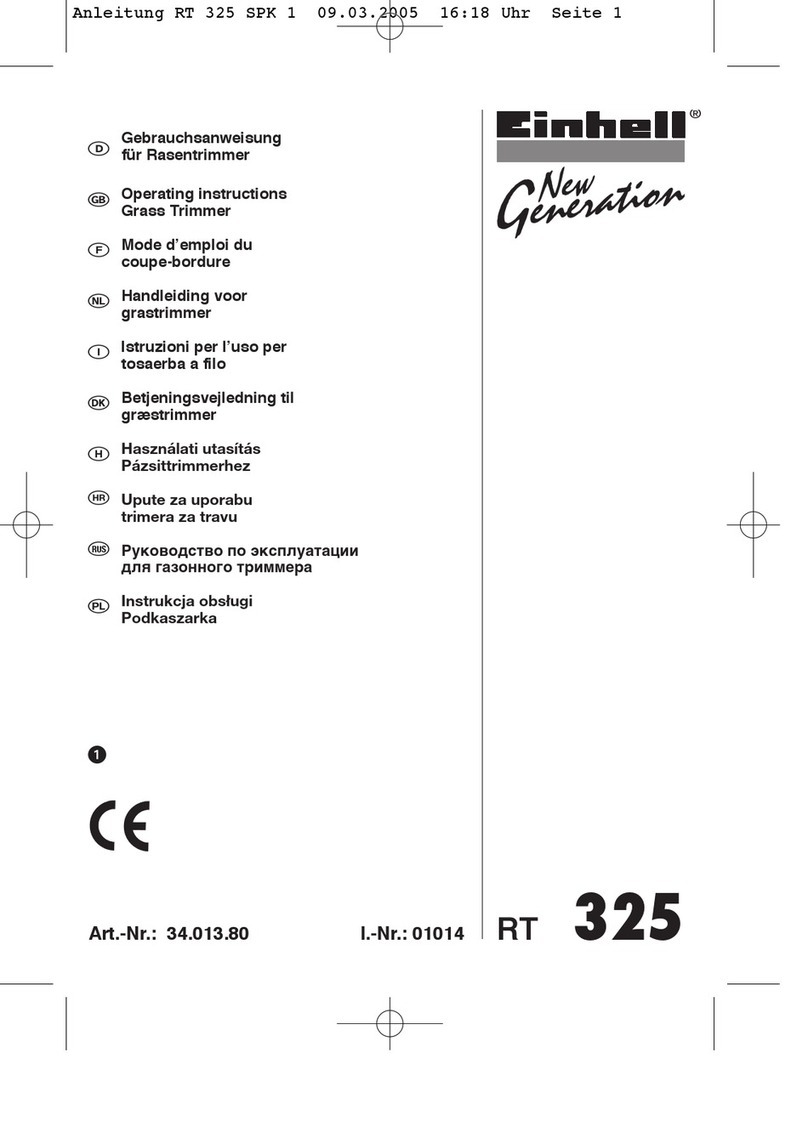
EINHELL
EINHELL 325 RT operating instructions
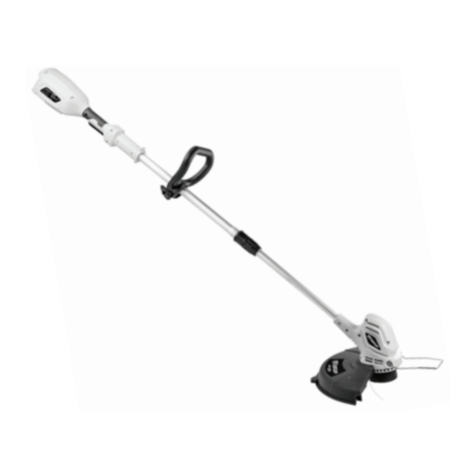
F.F. Group
F.F. Group BST 35/40V PLUS Original instructions

Husqvarna
Husqvarna 128CD Operator's manual
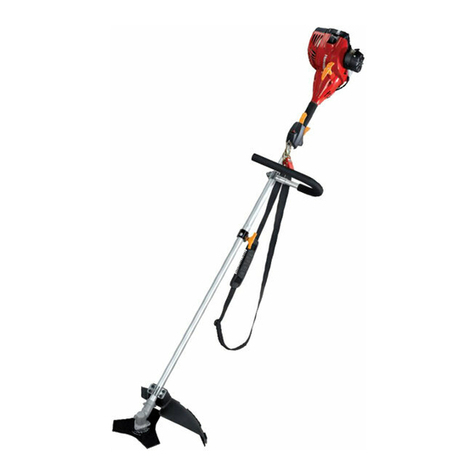
Homelite
Homelite HBC26SJ user manual

Craftsman
Craftsman WEEDWACKER Incredi-Pull 316.794400 Operator's manual

